| Oracle® Enterprise Manager Ops Center Lifecycle Management of Virtual Machines 12c Release 1 (12.1.2.0.0) Part Number E35863-01 |
|
| PDF · Mobi · ePub |
| Oracle® Enterprise Manager Ops Center Lifecycle Management of Virtual Machines 12c Release 1 (12.1.2.0.0) Part Number E35863-01 |
|
| PDF · Mobi · ePub |
Lifecycle Management of Virtual Machines
12c Release 1 (12.1.2.0.0)
E35863-01
November 2012
This guide provides an end-to-end example for how to use Oracle Enterprise Manager Ops Center.
The integration of Oracle VM Server for x86 with Oracle Enterprise Manager Ops Center provides the platform to manage Oracle VM Manager, Oracle VM Servers, server pools, and virtual machines through Oracle Enterprise Manager Ops Center.
A virtual machine includes a configurable set of resources and its own operating system. The resources include virtual CPU, memory, network, and virtual disks. After virtual machines are created, you can start, stop, and restart each virtual machine independently.
This example shows you how you can perform a set of basic operations to manage the lifecyle of a virtual machine created in an Oracle VM Server for x86 server pool. In Oracle Enterprise Manager Ops Center, you can only create virtual machines on Oracle VM Servers that are placed in a server pool.
The operations described in this example will enable you to perform configuration management actions to a virtual machine, such as adding storage, modifying CPU and memory allocation, or connecting networks among other actions.
See Related Articles and Resources for links to related information and articles.
You will need the following to manage the lifecycle of your virtual machines:
A user with the Virtualization Admin role.
A running virtual machine created in an Oracle VM Server for x86 server pool.
In this example, a virtual machine with the following characteristics is used:
Virtualization type is hardware virtualized machine (HVM)
A Linux distribution as the operating system
A memory size of 1024 MB
A virtual disk using an Oracle VM Storage repository
CPU thread is 1, capped to 50
Network interface is connected to a network
In this example, you use the Oracle Enterprise Manager Ops Center user interface (UI) to perform actions to manage the lifecycle of a virtual machine. These actions are described in the following sections:
Identifying the Status of a Virtual Machine - This section describes the available status for a virtual machine, and how to verify its current status.
Basic Virtual Machine Operations - This section describes how to reboot, shut down, start, suspend, resume, launch the virtual console, and delete a virtual machine.
In this example, you use the virtual machine dsl1 created in an Oracle VM Server for x86 server pool named OVMServerPool.
In the Oracle Enterprise Manager Ops Center UI, you can see a virtual machine in one of the following status:
Running – In this status, the virtual machine is powered on, and the OS and applications are running.
Shutdown/detached – In this status, the virtual machine is disconnected from its networks, disassociated from the Oracle VM Server control domain, and all the associated resources are released.
Suspended – In this status, the current state of the operating system, and applications is saved. The operating system and applications are moved to a suspended mode. The Oracle VM Server resources used by the virtual machine are not released.
Unreachable – In this status, the virtual machine cannot be contacted for information. This status indicates a network problem or a problem with the virtual domain or the Oracle VM Server.
You can verify the status of a virtual machine directly in the Navigation pane, or in the Dashboard page of the virtual machine.
In the Navigation pane, one of the following icons is placed next to the virtual machine to show its current status:
| Icon | Status |
|---|---|
| Running | |
| Shutdown/detached | |
| Suspended | |
| Unreachable |
In the Dashboard page of the virtual machine, you can verify its current status along with other information such as operating system, tags, running time, or incidents.
To verify the status of a virtual machine in the Dashboard page:
Expand Assets in the Navigation pane, then select Sever Pools from the list.
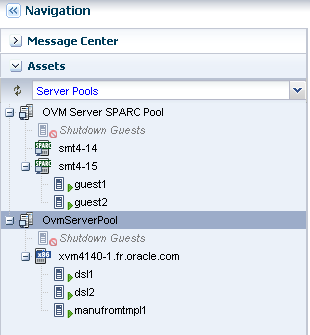
Select the virtual machine under the OVMServerPool server pool in the Navigation pane.
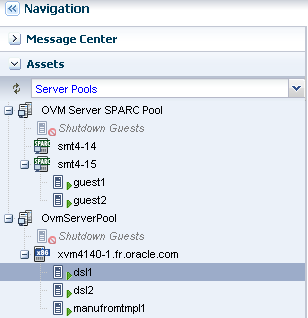
Verify that the status of the virtual machine is running.
The status is part of the information displayed in the Dashboard page of the virtual machine.

This section covers the following operations:
You can reboot a running or suspended virtual machine according to your needs. You might want to perform a reboot after a system configuration change or on any particular need for your applications.
In this example, you reboot a running virtual machine. As part of the reboot process, the virtual machine is shut down and then restarted.
Expand Assets in the Navigation pane, then select Server Pools from the list.

Select the virtual machine listed under the OVMServerPool server pool in the Navigation pane.
You can verify that the status of the virtual machine is running.

Click Reboot in the Actions pane.
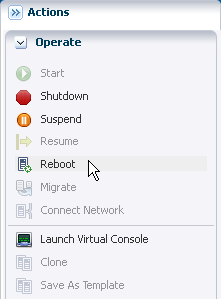
Click Reboot Guest to confirm. A job is created to reboot the guest.

Verify that the status of the virtual machine is changed back to running after the job completes.

You can shut down a running virtual machine to perform a configuration change such as connecting a network, or to move the virtual machine to a different Oracle VM Server or server pool. When shutting down a virtual machine its status is changed to shutdown/detached and resources are released from the Oracle VM Server.
In this example, you shut down a running virtual machine. Some actions, such as Connect Network, are only enabled in the UI for a virtual machine in shutdown/detached status.
Select the virtual machine listed under the OVMServerPool server pool in the Navigation pane.
You can verify that the status of the virtual machine is running. Also note that the Connect Network action is disabled in the Actions pane.

Click Shutdown in the Actions pane.
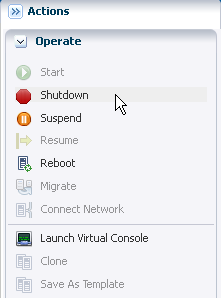
Click Shutdown Guest to confirm.
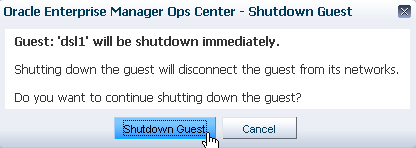
Verify that the status of the virtual machine is changed to shutdown/detached after the job completes.
After the job finishes, the virtual machine is listed under Shutdown Guests of the server pool and the Connect Network action is enabled in the Actions pane.

You can start a virtual machine in shutdown/detached status. When starting a virtual machine you can select the server pool and the Oracle VM Server on which to run the virtual machine.
In this example, you start a virtual machine in the same server pool, OVMServerPool.
Select the virtual machine listed under Shutdown Guests from the server pool in the Navigation pane.

Click Start in the Actions pane.

Select the server pool on which to run the virtual machine, then click Next.
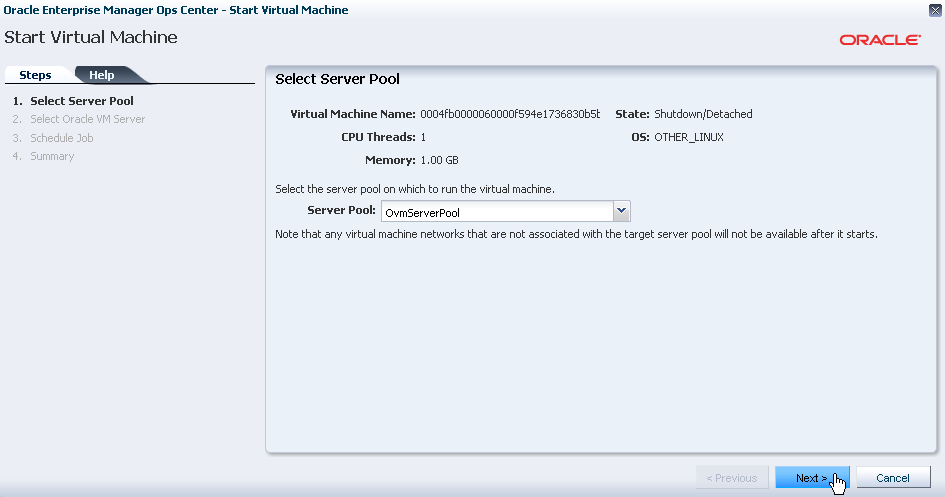
Select the Oracle VM Server to host the virtual machine, then click Next.
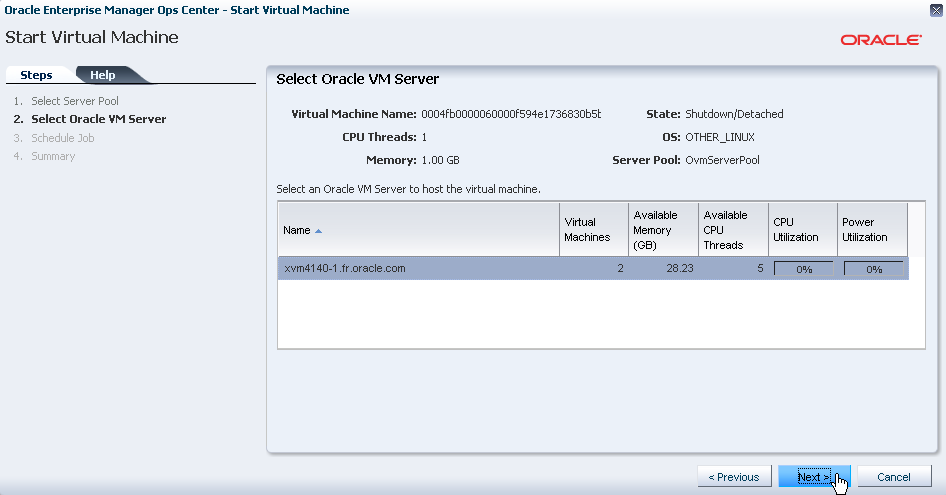
Select Now to start the virtual machine immediately, then click Next.
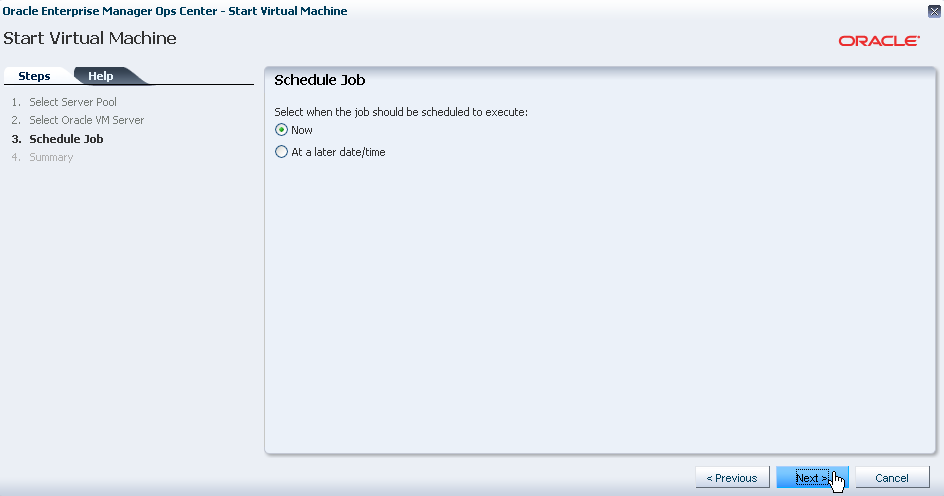
Confirm the information in the Summary, then click Finish.
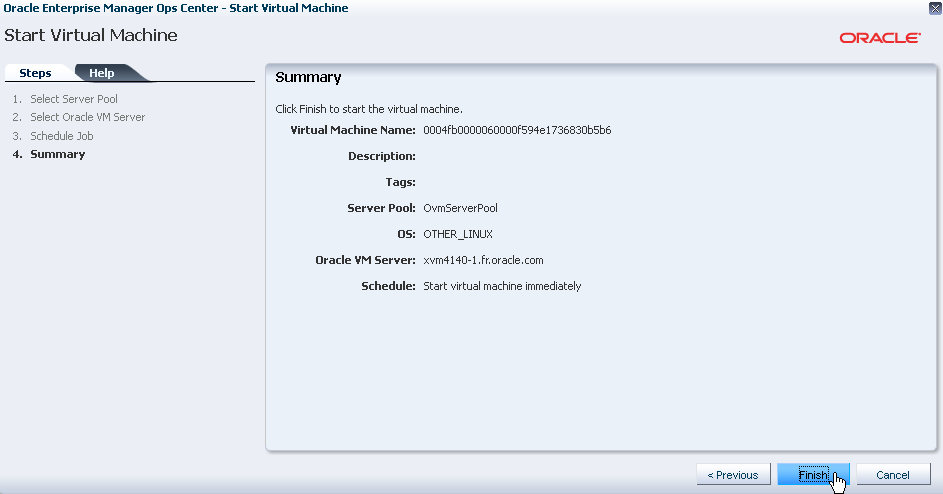
Verify that the status of the virtual machine changes to running after the job completes.

You can suspend a running virtual machine to stop it temporarily. Suspending a virtual machine saves the state of the virtual machine at a certain processing point so you can resume it quickly.
In this example, the Oracle VM Server resources used by the virtual machine are not released when the virtual machine is stopped.
Select the virtual machine listed under the OVMServerPool server pool in the Navigation pane.

Click Suspend in the Actions pane.
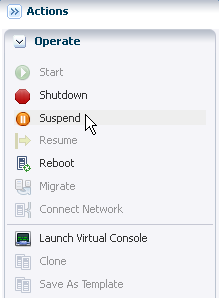
Click Suspend Guest to confirm.

Verify that the status of the virtual machine is changed to suspended after the job completes.

You can resume a virtual machine in suspended status to continue using it. The operating system and applications continue from the same point when you suspended the virtual machine.
Select the virtual machine listed under the OVMServerPool server pool in the Navigation pane.
You can verify that the status of the virtual machine is suspended.

Click Resume in the Actions pane.
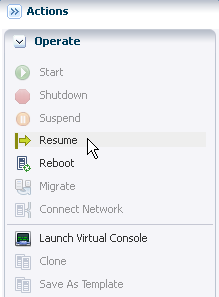
Verify that the status of the virtual machine changes to running after the job completes.

You can use the Launch Virtual Console action to connect to a virtual machine in running status.
This example opens the console to access a running virtual machine using a Linux distribution.
Select the virtual machine listed under the OVMServerPool server pool in the Navigation pane.
You can verify that the status of the virtual machine is running.

Click Launch Virtual Console in the Actions pane.
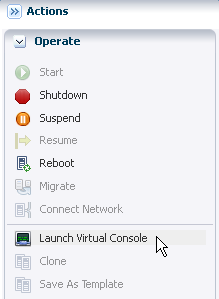
Click OK in the window requesting to open a Java proxy file.
Depending on the web browser you are using, you might receive a request to save the file first instead of just opening it.
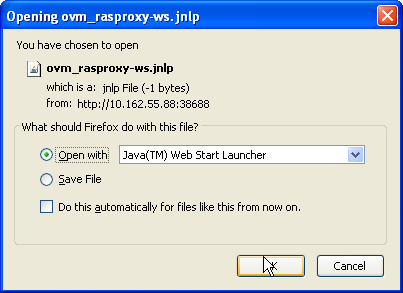
Verify the console opens after the job completes.
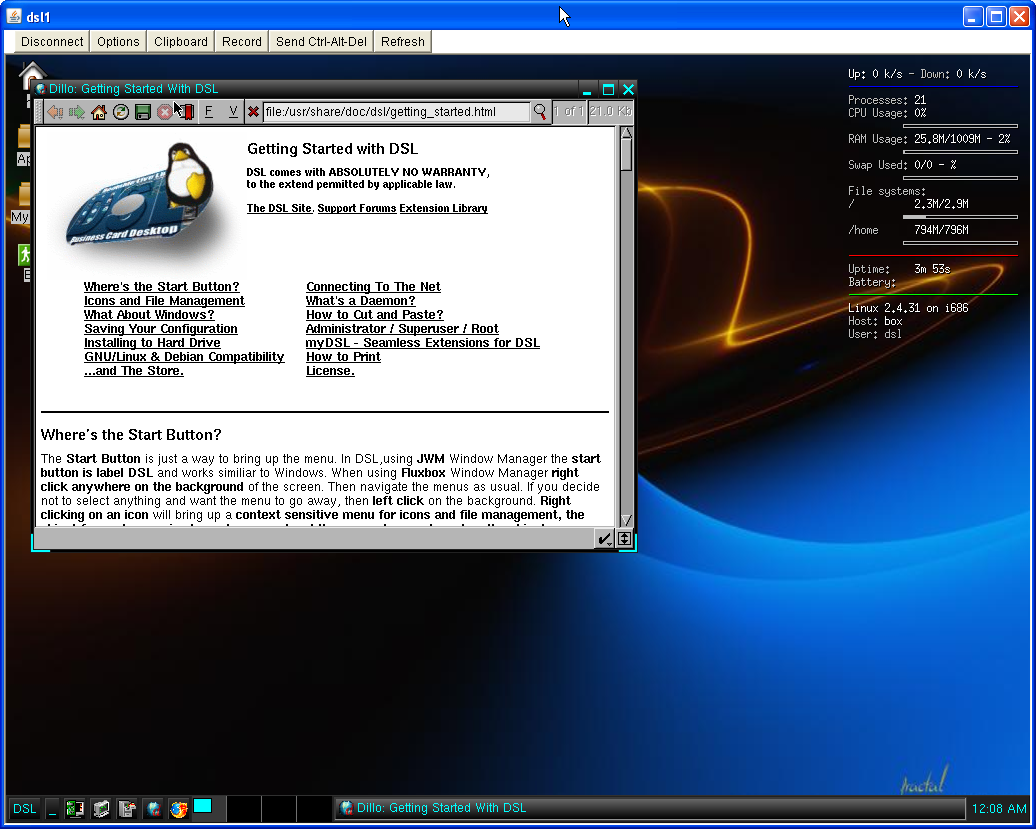
When you delete a virtual machine, all the files and data associated with the virtual machine are removed from Oracle VM Manager.
In this example, you delete a virtual machine in running status that is no longer needed. As part of the deletion process the virtual machine is changed to a shutdown/detached status first, then deleted from the Oracle VM Manager.
Select the virtual machine listed under the OVMServerPool server pool in the Navigation pane.

Click Delete in the Actions pane.

Click Delete Guest to confirm.

Verify that the virtual machine is no longer listed under the OVMServerPool server pool in the Navigation pane after the job completes.
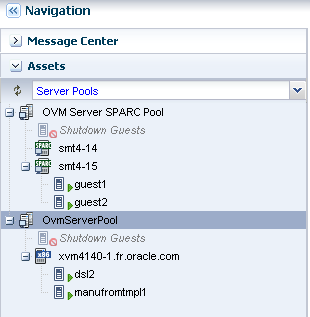
You can perform virtual machine configuration actions, such as add storage, modify CPU and memory allocation, or connect networks.
See the following documentation resources for more information about how to manage virtual machines:
Other examples are available at http://docs.oracle.com/cd/E27363_01/nav/howto.htm.
The following chapters in the Oracle Enterprise Manager Ops Center Feature Reference Guide contain more information about virtual machines and server pools:
For information about Oracle's commitment to accessibility, visit the Oracle Accessibility Program website at http://www.oracle.com/pls/topic/lookup?ctx=acc&id=docacc.
Oracle customers have access to electronic support through My Oracle Support. For information, visit http://www.oracle.com/pls/topic/lookup?ctx=acc&id=info or visit http://www.oracle.com/pls/topic/lookup?ctx=acc&id=trs if you are hearing impaired.
Oracle Enterprise Manager Ops Center Lifecycle Management of Virtual Machines, 12c Release 1 (12.1.2.0.0)
E35863-01
Copyright © 2007, 2012, Oracle and/or its affiliates. All rights reserved.
This software and related documentation are provided under a license agreement containing restrictions on use and disclosure and are protected by intellectual property laws. Except as expressly permitted in your license agreement or allowed by law, you may not use, copy, reproduce, translate, broadcast, modify, license, transmit, distribute, exhibit, perform, publish, or display any part, in any form, or by any means. Reverse engineering, disassembly, or decompilation of this software, unless required by law for interoperability, is prohibited.
The information contained herein is subject to change without notice and is not warranted to be error-free. If you find any errors, please report them to us in writing.
If this is software or related documentation that is delivered to the U.S. Government or anyone licensing it on behalf of the U.S. Government, the following notice is applicable:
U.S. GOVERNMENT END USERS: Oracle programs, including any operating system, integrated software, any programs installed on the hardware, and/or documentation, delivered to U.S. Government end users are "commercial computer software" pursuant to the applicable Federal Acquisition Regulation and agency-specific supplemental regulations. As such, use, duplication, disclosure, modification, and adaptation of the programs, including any operating system, integrated software, any programs installed on the hardware, and/or documentation, shall be subject to license terms and license restrictions applicable to the programs. No other rights are granted to the U.S. Government.
This software or hardware is developed for general use in a variety of information management applications. It is not developed or intended for use in any inherently dangerous applications, including applications that may create a risk of personal injury. If you use this software or hardware in dangerous applications, then you shall be responsible to take all appropriate fail-safe, backup, redundancy, and other measures to ensure its safe use. Oracle Corporation and its affiliates disclaim any liability for any damages caused by use of this software or hardware in dangerous applications.
Oracle and Java are registered trademarks of Oracle and/or its affiliates. Other names may be trademarks of their respective owners.
Intel and Intel Xeon are trademarks or registered trademarks of Intel Corporation. All SPARC trademarks are used under license and are trademarks or registered trademarks of SPARC International, Inc. AMD, Opteron, the AMD logo, and the AMD Opteron logo are trademarks or registered trademarks of Advanced Micro Devices. UNIX is a registered trademark of The Open Group.
This software or hardware and documentation may provide access to or information on content, products, and services from third parties. Oracle Corporation and its affiliates are not responsible for and expressly disclaim all warranties of any kind with respect to third-party content, products, and services. Oracle Corporation and its affiliates will not be responsible for any loss, costs, or damages incurred due to your access to or use of third-party content, products, or services.